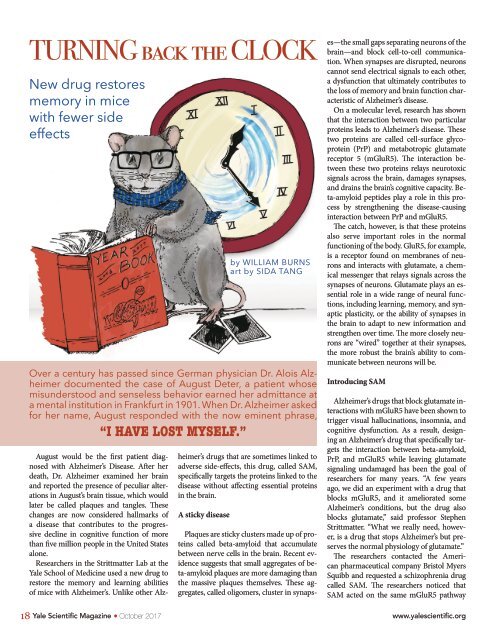YSM Issue 90.4
Create successful ePaper yourself
Turn your PDF publications into a flip-book with our unique Google optimized e-Paper software.
TURNING back the CLOCK<br />
New drug restores<br />
memory in mice<br />
with fewer side<br />
effects<br />
August would be the first patient diagnosed<br />
with Alzheimer’s Disease. After her<br />
death, Dr. Alzheimer examined her brain<br />
and reported the presence of peculiar alterations<br />
in August’s brain tissue, which would<br />
later be called plaques and tangles. These<br />
changes are now considered hallmarks of<br />
a disease that contributes to the progressive<br />
decline in cognitive function of more<br />
than five million people in the United States<br />
alone.<br />
Researchers in the Strittmatter Lab at the<br />
Yale School of Medicine used a new drug to<br />
restore the memory and learning abilities<br />
of mice with Alzheimer’s. Unlike other Alzheimer’s<br />
drugs that are sometimes linked to<br />
adverse side-effects, this drug, called SAM,<br />
specifically targets the proteins linked to the<br />
disease without affecting essential proteins<br />
in the brain.<br />
A sticky disease<br />
by WILLIAM BURNS<br />
art by SIDA TANG<br />
Over a century has passed since German physician Dr. Alois Alzheimer<br />
documented the case of August Deter, a patient whose<br />
misunderstood and senseless behavior earned her admittance at<br />
a mental institution in Frankfurt in 1901. When Dr. Alzheimer asked<br />
for her name, August responded with the now eminent phrase,<br />
“I HAVE LOST MYSELF.”<br />
Plaques are sticky clusters made up of proteins<br />
called beta-amyloid that accumulate<br />
between nerve cells in the brain. Recent evidence<br />
suggests that small aggregates of beta-amyloid<br />
plaques are more damaging than<br />
the massive plaques themselves. These aggregates,<br />
called oligomers, cluster in synaps-<br />
es—the small gaps separating neurons of the<br />
brain—and block cell-to-cell communication.<br />
When synapses are disrupted, neurons<br />
cannot send electrical signals to each other,<br />
a dysfunction that ultimately contributes to<br />
the loss of memory and brain function characteristic<br />
of Alzheimer’s disease.<br />
On a molecular level, research has shown<br />
that the interaction between two particular<br />
proteins leads to Alzheimer’s disease. These<br />
two proteins are called cell-surface glycoprotein<br />
(PrP) and metabotropic glutamate<br />
receptor 5 (mGluR5). The interaction between<br />
these two proteins relays neurotoxic<br />
signals across the brain, damages synapses,<br />
and drains the brain’s cognitive capacity. Beta-amyloid<br />
peptides play a role in this process<br />
by strengthening the disease-causing<br />
interaction between PrP and mGluR5.<br />
The catch, however, is that these proteins<br />
also serve important roles in the normal<br />
functioning of the body. GluR5, for example,<br />
is a receptor found on membranes of neurons<br />
and interacts with glutamate, a chemical<br />
messenger that relays signals across the<br />
synapses of neurons. Glutamate plays an essential<br />
role in a wide range of neural functions,<br />
including learning, memory, and synaptic<br />
plasticity, or the ability of synapses in<br />
the brain to adapt to new information and<br />
strengthen over time. The more closely neurons<br />
are “wired” together at their synapses,<br />
the more robust the brain’s ability to communicate<br />
between neurons will be.<br />
Introducing SAM<br />
Alzheimer’s drugs that block glutamate interactions<br />
with mGluR5 have been shown to<br />
trigger visual hallucinations, insomnia, and<br />
cognitive dysfunction. As a result, designing<br />
an Alzheimer’s drug that specifically targets<br />
the interaction between beta-amyloid,<br />
PrP, and mGluR5 while leaving glutamate<br />
signaling undamaged has been the goal of<br />
researchers for many years. “A few years<br />
ago, we did an experiment with a drug that<br />
blocks mGluR5, and it ameliorated some<br />
Alzheimer’s conditions, but the drug also<br />
blocks glutamate,” said professor Stephen<br />
Strittmatter. “What we really need, however,<br />
is a drug that stops Alzheimer’s but preserves<br />
the normal physiology of glutamate.”<br />
The researchers contacted the American<br />
pharmaceutical company Bristol Myers<br />
Squibb and requested a schizophrenia drug<br />
called SAM. The researchers noticed that<br />
SAM acted on the same mGluR5 pathway<br />
18 Yale Scientific Magazine October 2017 www.yalescientific.org


















